Given that the Mitsubishi EclipseCross is priced higher than its better-equipped rivals – models like the Subaru Crosstrek and Honda HR-V – and given that it’s a bit less roomy – is there any sound reason to consider buying one?
There’s a big one, actually.
Plus another one.
The big one is the fact that it’s a Mitsubishi – which can benefit your pocketbook.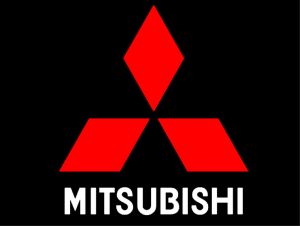
Subaru and Honda – and the other big names – negotiate from a position of familiarity and strength. They have buyers lined up out the door – and if your offer isn’t high enough, the dealer knows he can wait for the next buyer to make a better offer.
Mitsubishi, on the other hand, is fighting hard for market share; fighting to get noticed by prospective buyers – many of whom aren’t even aware the ElcipseCross exists.
Or that Mitsubishi does.
That means your local Mitsu dealer is much more likely to be willing to . . . deal.
Oh – and that other thing?
The EclipseCross is a subcompact, five-door crossover SUV that’s similar in layout and size to others in this class like the Subaru Crosstrek and Honda HR-V.
It’s available in front-drive and all-wheel-drive versions, like most of the others – and unlike some of the others, it comes standard with a punchy turbocharged engine.
This is something that neither the Subaru Crosstrek nor the Honda HR-V even offer – no matter how much you offer.
Mitsu asks $22,845 for the front-wheel-drive EclipseCross ES – which is $950 more than Subaru asks for the AWD-equipped Crosstrek ($21,895) and $2,225 more than Honda is asking for the base/FWD version of the HR-V.
A top-of-the-line EclipseCross SEL with AWD stickers for $28,595.
The EclipseCross is a new vehicle from Mitsubishi that resurrects an old name – the Eclipse part. That was the name of Mitsubishi’s two-door sports car, which Mitsubishi doesn’t make anymore. The hope is that bringing back the name will convey sporty memories.
The Cross part is meant to convey the obvious – or desirable – when people shop crossover SUVs.
Thus, a sporty crossover – and one with a name instead of another number.
Hey, that’s one more thing!
UNDER THE HOOD
The EclipseCross has one of the smallest – but strongest – engines in the class. It comes standard with a 1.5 liter four cylinder engine – vs. a 2.0 liter engine in the Subaru Crosstrek and a 1.8 liter engine in the HR-V.
But it makes 152 horsepower – the same as the Subaru’s larger 2.0 liter engine and more than the Honda’s also smaller 1.8 liter engine (141 hp) as well as much more torque – the twisting force that is what gets a vehicle moving.
There’s 184 ft.-lbs. on tap (at 2,00 RPM) vs. 152 ft.-lbs. (at 4,000 RPM) in the Soobie and only 127 ft.-lbs. (at 4,300 RPM) emanating from the HR-V’s boiler room.
While none of the vehicles in this class are hot rods, the EclipseCross is slightly hotter than its main rivals, getting to 60 in 9 seconds flat vs. closer to 10 for the Subaru and in between 9 and ten for the lighter but less powerful Honda.
All versions come standard with a continuously variable (CVT) automatic transmission that has eight simulated gears.
CVTs, by definition, have ratios rather than gears. The difference is that the CVT transmission transitions from ratio to ratio – continuously varying that ratio – without shifting. A geared transmission “steps” (up or down) from gear to gear; the ratios chosen by the engineers are fixed.
But the CVT can be held at a given ratio, to simulate a fixed gear (e.g., first, second and so on) but without the gear-changing (and shift shock) one experiences with a fixed-geared transmission.
Some people like the smoothness of CVTs; others dislike the absence of gear-changing (even when simulated, it’s not the same). But one thing’s inarguable about CVTs: They are more efficient than fixed-gear transmissions, so you end up with slightly better mileage vs. a fixed-gear transmission.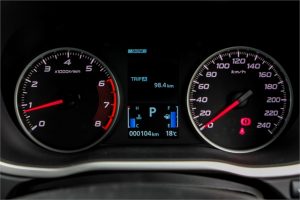
Speaking of that:
Some reviewers give the EclipseCross demerit points for lesser fuel economy than its rivals (which are also CVT-equipped). The Mitsu manages 26 city, 29 highway for the FWD version and 25 city, 28 with AWD – a bit less than the others but well within the margin of error for the class. The Crosstrek (AWD) rates 27 city, 33 highway; the FWD HR-V posts 27 city, 31 highway.
Not a big whoop’s difference.
The little turbo’d engine is a regular fuel engine, too. Unfortunately, it’s a direct-injected engine, so there’s the potential for carbon fouling as the miles rack up. The Crosstrek’s engine has the same vulnerability – but the Honda HR-V’s engine isn’t (yet) direct injected.
The Mitsu’s optional AWD (styled Super All Wheel Control) can modulate power delivery to individual wheels, not just front-to-back. This is a handling advantage as well as a traction advantage, because the system can use the individualized power flow to stabilize the vehicle’s line while cornering, correcting for under-and-oversteer without using the ABS to pump the brakes (a clunkier way of accomplishing the same thing).
Like Subaru – which developed a high-performance AWD system for its WRX and WRX STi sports cars – Mitsu has the legacy of the high-performance Lancer EVO to draw on.
And unlike Subaru, Mitsu gives you the option to skip AWD entirely – if you don’t feel the need for the extra grip in the corners (and bite in the snow) and prefer a simpler drivetrain with fewer parts to potentially replace.
The EclipseCross feels much stronger than its rivals in stop-and-go driving especially, where it has the advantage of that turbo-boosted torque. The non-turbo’d Crosstrek and HR-V need to be revved before they move. Neither has much guts below 4,000 RPM.
They’re ok once rolling, but getting rolling is the challenge.
The Mitsu also benefits from a really steep final drive ratio – 6.386 – which gives the leverage of an eighth -mile bracket racer, but without the screamin’ Mimi RPM at the end of the eighth mile (or at 80 MPH) because of a commensurately deep .404 overdrive ratio, courtesy of the CVT.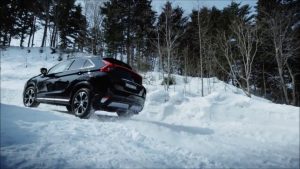
To put this in some perspective, a V8 muscle car will typically have a 3.23-3.90 final drive ratio and an overdrive ratio in top gear around .67 or so. If the Mitsu had the power of a V8 muscle car, it’d be a 10 second quarter-miler with a 200 MPH top end!
Speaking of things high-speed:
The CrossTrek also feels exceptionally planted on the highway – for a crossover – because it’s heavier – and lower to the ground.
Mitsubishi gave it eight inches of ground clearance – not quite as much as the Crosstrek’s class-leading 8.7 inches – but enough clearance to be good in the snow without getting too much air under the thing, the enemy of stable handling at highway speeds.
The Eclipse also has longer highway legs than some of its rivals – even if it gets slightly less miles-per-gallon – because it has a nice big gas tank (16.2 gallons).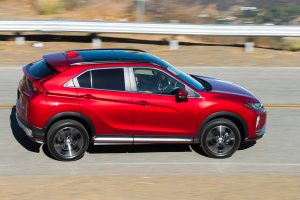
It also has a tight turning circle – 35 feet (vs. 37.4 for the HR-V).
FWD versions have something over the FWD versions (and some AWD versions) of rival crossovers, too: A standard yaw control system that uses selective application of the ABS to maintain stability during high-speed cornering. It lets you keep the power on while in the curve without unsettling, computer-ordered dialing back of the the throttle – which some other systems automatically do when a vehicle begins to squeal tires in the curves.
If you like that kind of action, the Mitsu allows more of it . . . echos of the EVO.
AT THE CURB
Crossovers are bought mostly for their utility, not their individuality. Here you get a bit more of the former – in exchange for a bit less of the latter.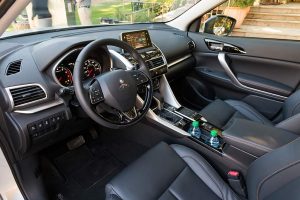
Dramatic upward arcing “swoosh” lines are stamped on each side that meet to form the ends of a flying wing single-piece rear brake/parking light panel that will make it easy to find your Mitsu in a parking lot full of other-brand (but look-alike) crossovers.
There’s a lower arc-line stamped into the rocker panel along the door bottoms that tapers in parallel, then swooshes upward as it hockey-sticks toward the rear, then flows over the rear wheelwell, creating a haunchy squat – like a cat getting ready to leap on its prey.
It’s maybe a bit fustian – but at least it’s not same-same.
There’s a bit less room for legs and cargo, though.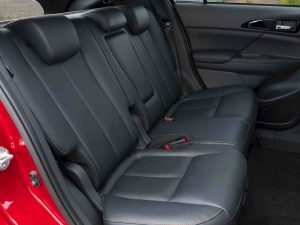
The second row has 35.3 inches of legroom vs. 39.3 in the HR-V and 36.5 in the Crosstrek. Cargo room specs out at 48.9 cubic feet, total vs. 57.6 in the Honda and 55.3 in the Subaru.
But – as with the gas mileage difference – it’s not a huge difference.
For a vehicle that’s only 173.4 inches long (for a sense of the smallness of this footprint, a Honda Civic sedan is 182.3 inches long) the Mitsu is very roomy. Especially for cargo. The almost-a-foot-longer Civic sedan has only 15.1 cubic feet of trunk space.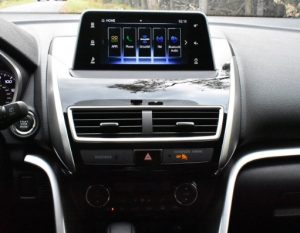
Mitsu cribbed some interior styling touches from others – including the BMW-looking iPad-style seven-inch LCD touch screen to the right of the dashboard – and the Lexus-like mouse trackpad on the center console.
Also Lexus-like are such options as rear seat heaters, a Heads-Up-Display and an excellent, 710 watt Rockford Fosgate premium audio rig with huge bass boomers mounted in the cargo area.
But you can’t get many of these items unless you buy the higher LE and SEL trims, which can push the price to almost $30k. That’s a lot of money for what is still fundamentally a subcompact and entry-level crossover.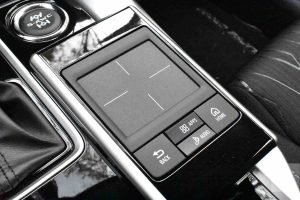
Mitsu does allow you to buy some options a la carte, including the panorama sunroof and heated rear seats.
One possibly creepy thing that comes standard in all trims is Firmware Over The Air (FOTA) “updates” sent from the Hive Mind via the MitsubishiConnect system. The good news is it’s subscription-based and you can decline to “subscribe.”
THE REST
Mitsu – like VW – is a brand trying to recover customers. Both brands hit upon the idea of offering much-better warranty coverage than competitors as an inducement. Blue chip brands like Honda and Subaru can still get away with offering three-year/36,000 mile basic coverage on their cars.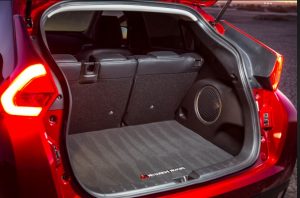
Mitsubishi offers a five year/60,000 mile standard warranty and extends the powertrain coverage to ten years/100,000 miles.
This can be seen as the equivalent of spending a couple grand extra for an extended warranty on a Crosstrek or HR-V.
And there’s the Haggle Factor to consider. The chances of rolling out of a Mitsu store in a new EclipseCross for much less than sticker are much higher than accomplishing the same in a new Crosstrek or HR-V.
The downside is that Mitsu stores are fewer – and it may be harder to find one near you. But that is mostly a one-time pain in that you can get the thing serviced almost anywhere, once you’ve bought the thing.
There is one other downside: Depreciation.
Because Mitsu is struggling to rebuild, Mitsu’s vehicles lose value faster than the blue chips. That has no bearing on the soundness of Mitsubishi vehicles, per se – but it does mean your EclipseCross will probably be worth less as a used EclipseCross than the equivalent blue chips.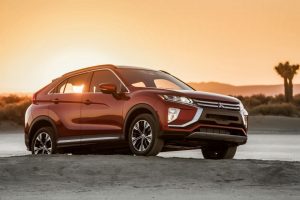
That will matter if you trade-in. But it’s irrelevant if you plan to drive it until the wheels fall off.
If you can pick one up for say $24k loaded up, it’s still a deal – depreciated or not.
THE BOTTOM LINE
The EVO was exciting; the Eclipse was fun. This one’s more practical – and it just might sell.
. . .
Got a question about cars, Libertarian politics – or anything else? Click on the “ask Eric” link and send ’em in!
If you like what you’ve found here please consider supporting EPautos.
We depend on you to keep the wheels turning!
Our donate button is here.
If you prefer not to use PayPal, our mailing address is:
EPautos
721 Hummingbird Lane SE
Copper Hill, VA 24079
PS: Get an EPautos magnet (pictured below) in return for a $20 or more one-time donation or a $10 or more monthly recurring donation. (Please be sure to tell us you want a sticker – and also, provide an address, so we know where to mail the thing!)
My latest eBook is also available for your favorite price – free! Click here. If that fails, email me and I will send you a copy directly!


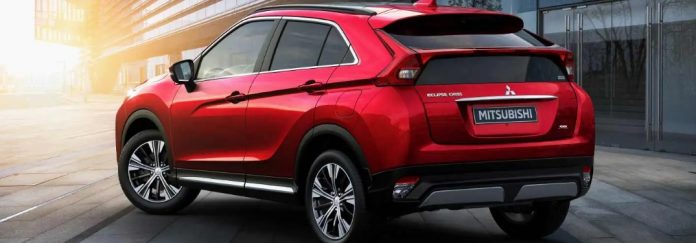

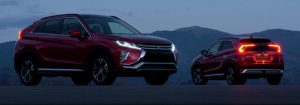
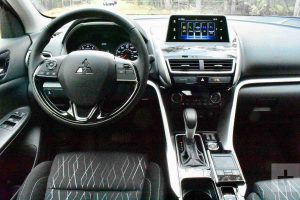

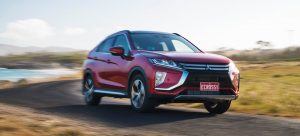








Since pretty much any car from a major Japanese, German, or American manufacturer nowadays are reasonably reliable and offer decent performance, I’ve been buying lately based on cost/performance (interior space, MPG, speed, etc.) To that end, I currently have a 2018 VW Golf Sportwagen and 2018 Mitsubishi Outlander (the 7 passenger version) in my garage. Both are mid-level trims, and were bought for less than $25K OTD. The Mitsu for ~$23K and the VW for a bit under ~$25K. Tip — wait until the new year models are about to be released and buy a “leftover” new model for thousands off MSRP and whatever deal you can work. I would have had to pay at least $10K+ per vehicle to get equivalent trim/performance from one of the “non-tainted” manufacturers. I’ve had something like 13 Subarus over the years and am still a fan, but for the price and features (and WARRANTY!) you can’t beat VW or Mitsubishi right now.
Good stuff, Anonymous!
I have been giving the same advice to anyone who asks me. I am a particularly big fan of the Mitsu Mirage; it’s a fantastic little runabout and you can easily buy one brand-new for about $12k.
Good point, Eric.
When are you going to do a review of the Mirage? I searched your archive and no can do. Maybe I’m mistaken and didn’t do the search right.
I’m honestly thinking of buying one for my wife as a snowbird runabout here in Florida.
Eric did a review of the 2019 Mirage back in January:
https://www.ericpetersautos.com/2019/01/29/2019-mitsubishi-mirage/
Hi Eric, my wife has a 2004 Mitsubishi Outlander with Awd and 250,000 miles and it keeps going! We replaced an alternator recently but have done no major work. Do you think the new model will be that reliable?
I wonder if Nissan forced the JATCO CVT technology into the Mitsubishi’s since they are now partners. Go from that…
You sound like Scotty Kilmer. lol. He probably is single handedly responsible for cratering resale on Nissans and the fact that no one will sell you a 2004 Camry for less than 10k.
Wouldn’t surprise me if Toyota is somehow ensuring that Mr. Kilmer, whom talks with his hands more than most “Eye-Talians”, gets “monetized” for his YT productions. The Japs are known to get what they want in a sneaky fashion if they can’t beat ya in a “fair” fight, as we come up on another Dec 7th it’s well to remember Pearl Harbor.
Not the Japs fault they bombed Pearl Harbor. Might look into what FDR did to them first.
Yeah, we made them invade China too!
Read Robert Stinnett’s “Day of Deceit”. Also, look at something called McCollum Memo; it’s an eight point plan to provoke Japan to attack us. If you carefully go through the McCollum Memo and juxtapose it with history, you’ll note that the US gov’t did EVERY STEP on the memo to provoke Japan in to attacking us.
You’ll also find Roosevelt assured the American public 5 times no US soldiers would fight overseas. Cue the old adage “how can you tell a politician is lying?”.
Hear, hear. FDR knew.
HI SCOTTY KILMER HERE! TURN DOWN YOUR VOLUME!!!!1!
This review made my teeth hurt. There is nothing compelling about this vehicle to make me want to shell out $25.00 much less $25k for this car. It doesn’t excel in any category and has a CVT. Uck. The way Mitsu could make a splash is to make a RWD based crossover. It might be interesting
I’m still not a fan of the CVT. Never owned one, just know a couple folks with Nissans that had to pony up for a replacement. Once the reliability is there, or even make repairing it simple I’d consider it.
A garbage truck backed over the wife’s Blazer when I was living in an alley in my RV. She got a rent car, a Versa. What a rattly, loud, rough little POS and didn’t get very good mileage. Some people care more about things other than fuel mileage, me being one.
old experiences die hard. way back in the 70’s, boom-boxes were a big deal to us. I bought a Mitsubishi. It’s tape deck was misaligned and didn’t work. returned it the old fashion way, back then, and had to get my parents to give me a ride. got another one and it too had the same tape deck problem. i returned it again for my $ back.
It’s amazing to me that over 40 years later, my brain still associates Mitsubishi with that crappy boom-box, but it does.
I still associate them with the planes that they bombed us with in WW2.
My dad, a bombardier in Japan refused to get in my minivan powered by a Mitsubishi.
He actually bombed their factory in 1944.
Does your dad have any circuits or electronics in his house?
So did the B-29 named “Bock’s Car” that dropped the second atomic bomb (a plutonium implosion device, the same type as tested in New Mexico the prior month), due to cloud cover, and after aborting the PRIMARY target, the city of Kokura (hence a modern Japanese slang expression, “Kokura ‘luck’ “, for evading unknown but impending doom), made a few attempts at a bomb run, and, having strict orders to bomb only visually, decided to defy them and drop by radar rather than deposit the bomb in the “drink”, but, at the last moment, enough of the cloud cover opened up that they could identify the Mistubishi factory in the Urakami valley, so it was a bad day to show up at work! This decision did drop the civilian casualties that would have otherwise resulted by about half, but still, things got rather ‘hot’, at least for a few seconds, in Nagasaki that day…
yeah lets make light of mass murder jackass
I believe it was Gen. Curtis LeMay who said American leaders would be prosecuted for war crimes if we had lost the war, not only for the use of the A bomb but also for the fire bombing of Tokyo. History is written by the winners.
Hi Rik,
Indeed. I think Chester Nimitz testified as a friendly witness on behalf of Admiral Doenitz, whose tactics were more or less the same as those used by the allied naval commanders.
Also: Why did Julius Streicher swing? An asshole? Certainly. But – as far as I recall – he didn’t kill anyone or order them killed. He published a hate-rag (Der Sturmer) but… so what? We go down a very dangerous road when it becomes a crime (a capital crime) to speak/write things considered (and even actually) hateful.
Rik, LeMay should know. I’m sure he included himself in the fray. You won’t see it in “official” history but LeMay carpet bombed N. Korea. I’d support him for this.
There’s a reason the pics you see of the Korean war were ones of total destruction. The landscape was a few parts of trees barely above ground and holes from various types of ordnance.
I don’t believe in war. It’s rarely, very rarely, the only solution. But when you get into a war, things like the Geneva rules are total bullshit and professional soldiers know it and after a bit, never consider it again.
Rifles firing non-expanding bullets is a good example. So then the bullets getting fired simply get larger and larger and don’t expand but explode(that’s ok).
Wow, your right, forgot about that important piece of history. Thx.
Don’t forget that the A6M Zero, FW190, and our radial engined fighters ALL stole from Howard Hughes’ H-1, and the aerodynamics it pioneered…
The radial-engined fighter was hardly new…look at the 1932 “GeeBee” racer. Still, Hughes’ H-1 was a leap forward, although it’s probably fortunate that Mitsubishi copied it almost TOO literally for their own good…the H-1 was a fragile bird, and would have been useless as a pursuit aircraft. The A6M “Zero” or “Zeke” did have significant advantages over the extant P-40 “Warhawk” in terms of turning radius and rate of climb (the latter being especially important as the time-honored method to “bounce” hostile aircraft is to dive with the sun to your back and up, making it hard for your opponent to acquire you) and also the F4F Wildcat, but it couldn’t take much in terms of battle damage, which was bad enough in loss of aircraft for the IJN, but worse, PILOTS. As tactics and performance for US Navy and Marine Corps aircraft improved, and certainly the Japanese had nothing in mass production like the P-47s and P-51 that the USAAF had by war’s end, the “Zeros” were cannon fodder for Navy and Marine aircraft.
Finally, a compact crossover that isn’t an anonymous blob and has some styling to it.
(looking at you, MBUSA, with the snooze-fest GLC)
There is a Mitsu dealer in town and they’re pretty good. But I do have to wonder if the brand is going to stick around the US market.
I’m going to the auto-show next week with some friends, hopefully The Diamond will be there.
Hi Chip,
Amen!
Writing about crossovers is hard – because for the most part, they’re all the same. It was a pleasant thing to write about one that’s a bit different, for once!
Eric, you may need to stock up on antidepressants in preparation for your electric Mustang CUV review!
If you wait until the end of the 2020 model year, you’ll probably be able to buy one that’s depreciated shockingly, even before you drive it off the dealer’s lot. 🙂
There’s just no coming back after offering that “No First Year Payments” financing option, as Mitsu once did.
OMG……just realized there’s not one single reference to the VW Diesel Emissions Scandal in this whole article.
BRAVO!
Hi Mike,
Well… thanks! 🙂